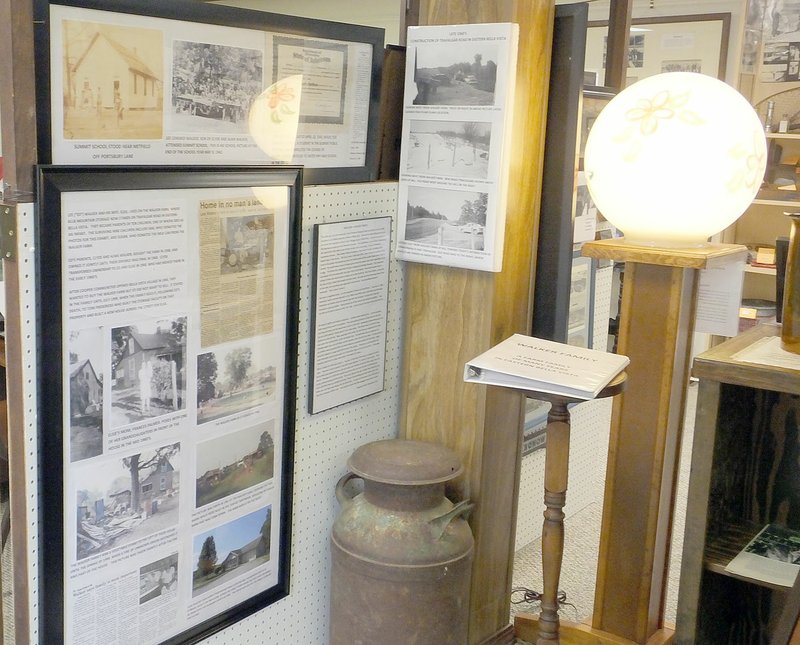With a room dedicated to the Cooper Community years and another to the early resort years, the Bella Vista History Museum has much of the region's history covered. There's even an exhibit about becoming a city in 2007.
But something was missing, said Xyta Lucas, co-president of the Bella Vista Historical Society. There wasn't very much information about the farming community that preceded Cooper Communities' vast expansion of the resort.
The Bella Vista Resort -- now commonly known as Old Bella Vista -- was started in 1916 with a dam across Little Sugar Creek forming Lake Bella Vista. Although the resort changed hands twice, it never grew very far beyond the area adjacent to the new lake. By the early 1960s, the resort was owned by E.L. Keith.
When John Cooper Sr. first started buying land for a retirement community, no one was sure of his plans, according to Gilbert Fite's history, "From Vision to Reality." Residents heard rumors about the reason for the land sales, ranging from a huge cattle ranch to the discovery of gold, but no one was sure. Most of the land, between the old resort and the Missouri state line, was farm land. By mid 1963, Cooper's company, then known as Cherokee Village Development Co., owned 41 pieces of property totaling 7,000 acres.
In January 1964, the resort's owner, E.L. Keith sold Cooper 1,100 acres, including Lake Bella Vista along with the rights to the name.
But not all the farmers in the area sold their land to Cherokee Village Development Co.
Lee Edward Walker was one of the holdouts.
Walker had grown up in the area and graduated from the Summit School, a one-room school house located near what is now the Metfield Clubhouse. In 1953 he married Elsie Palmer and they started a large family. Although they moved around a lot at first, in 1961 they settled on the family farm.
His youngest son, Sam Walker, was born in 1973. Sam grew up surrounded by Bella Vista, but not part of Bella Vista. The family cut wood and grew vegetables to make ends meet. In 1990 a fire of unknown origin destroyed the vegetable stand and damaged the house, but the family stayed on in the undamaged portion of the home.
In 1988, Lee Walker told a reporter that he planned to turn some of his fields into a storage area for recreational vehicles, but he never did. He died in January 1999.
Sam and his mother Elsie, sold the farm to Tom Fredericks in 1999. As part of the deal, Fredericks built a home for Elsie Walker nearby. Shortly after the sale, Fredericks told a Vista reporter that he wanted to build "high priced apartments" on the land if he could get water and sewer service. Because the land was never part of the POA, it did not have access to the POA water system. Eventually Fredericks opened Blue Mountain Storage on the land.
Recently Sam Walker came to the museum to meet a museum board member after connecting on Facebook, Lucas said. She was there for the meeting and told Walker about her interest in farming before Cooper's expansion. He returned with family photos and information that Lucas turned into an exhibit. Sam Walker's sister, Susan Ward, loaned a milk can to exhibit as well.
After talking to Walker and other long-time residents, Lucas believes the biggest crops in this area were tomatoes and strawberries. Lee Walker told stories about the old Summit School being closed for a week so students and teachers could all help with the strawberry harvest. When strawberries are ripe, they really can't wait to be harvested.
During the years when the resort was thriving, farmers had a near by market for the vegetables they grew. There was also a tomato canning company operating in the area, she discovered. Most of the farms probably had a few cattle and pigs, as well as chickens, she said. One of her sources talked about bringing the sheep in every night.
On display at the museum is an old map of Bella Vista that shows the locations of hold outs -- the farmers who didn't sell to Cooper. It's not that different from a current map which still shows chunks of land outside the POA. Those islands are part of the city of Bella Vista even if they aren't part of the POA.
The Walker exhibit adds one more piece of history to the story of Bella Vista.
General News on 06/22/2016
